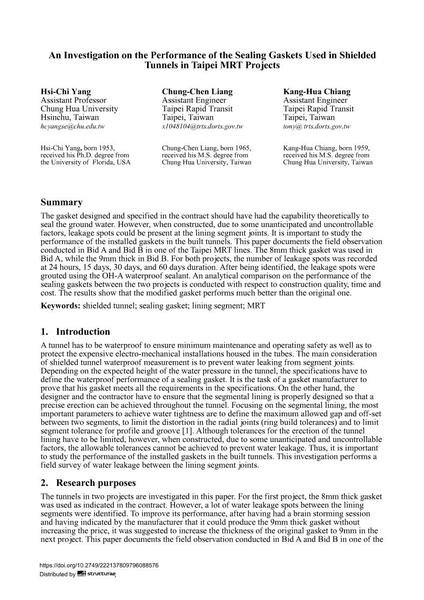An Investigation on the Performance of the Sealing Gaskets Used in Shielded Tunnels in Taipei MRT Projects

|
|
|||||||||||
Bibliografische Angaben
| Autor(en): |
Hsi-Chi Yang
Chung-Chen Liang Kang-Hua Chiang |
||||
|---|---|---|---|---|---|
| Medium: | Tagungsbeitrag | ||||
| Sprache(n): | Englisch | ||||
| Tagung: | IABSE Symposium: Sustainable Infrastructure - Environment Friendly, Safe and Resource Efficient, Bangkok, Thailand, 9-11 September 2009 | ||||
| Veröffentlicht in: | IABSE Symposium Bangkok 2009 | ||||
|
|||||
| Seite(n): | 138-145 | ||||
| Anzahl der Seiten (im PDF): | 6 | ||||
| Jahr: | 2009 | ||||
| DOI: | 10.2749/222137809796088576 | ||||
| Abstrakt: |
The gasket designed and specified in the contract should have had the capability theoretically to seal the ground water. However, when constructed, due to some unanticipated and uncontrollable factors, leakage spots could be present at the lining segment joints. It is important to study the performance of the installed gaskets in the built tunnels. This paper documents the field observation conducted in Bid A and Bid B in one of the Taipei MRT lines. The 8mm thick gasket was used in Bid A, while the 9mm thick in Bid B. For both projects, the number of leakage spots was recorded at 24 hours, 15 days, 30 days, and 60 days duration. After being identified, the leakage spots were grouted using the OH-A waterproof sealant. An analytical comparison on the performance of the sealing gaskets between the two projects is conducted with respect to construction quality, time and cost. The results show that the modified gasket performs much better than the original one. |
||||

